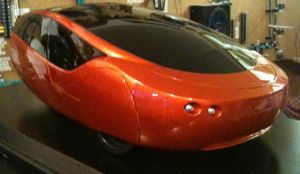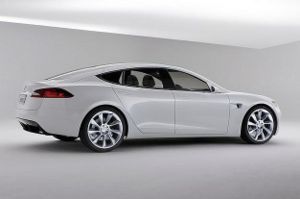Automated transport systems/Efficient, autonomous cars
Personal Rapid Transit is the most efficient way to move people around a city, while VacMagLev is the most efficient way to move people and goods long distances. However, these systems require large infrastructures and — for now — are probably feasible only in planned towns and new developments. Existing infrastructure is dominated by roads. For example, in the European Union, 44% of goods and 85% of people are transported by road [2]. Shifting some of this onto rail will increase efficiency, but we can also get much better use out of our road system. We have the technology to make self-driving, electric cars that use a fifth the energy of conventional cars and are much safer.
Contents
Current situation
Currently, cars are very wasteful of energy, are responsible for 28% of greenhouse gas emissions [3] and waste a lot of valuable urban space. They are also extremely dangerous. Due to its everyday nature, we sweep under the carpet how risky driving really is. The annual global death toll in road accidents is an amazing 1.2 million people per year and 15 million people are seriously injured[4][5]. This is the equivalent of Auckland, the biggest city in New Zealand, being nuked each year, and every man, woman and child in New York and Hong Kong being severely injured every single year. Unbelievably, of everyone who died worldwide in 2002, 2% - one in fifty - were killed by road traffic accidents [6][7]. Road traffic accidents are the number one killer of young people [8] and by far the leading cause of accidental death [9]. This is clearly unacceptable.
Then there is the question of traffic congestion. An efficient transport system, by definition, would use space optimally, co-ordinate the movements of different vehicles so they do not block each other, and put each vehicle to full use. Road-based transport is currently far from this ideal; at peak times, only 8% of the space on motorways is actually occupied by a car [10], traffic jams eat up 4.2 billion man-hours a year in the US alone [11] and cars spend 96% of their time parked[12], during which time they do nothing but take up valuable space.
Efficiency
A car's energy efficiency is often expressed in miles-per-gallon (mpg), the number of miles a car can travel using the energy contained in one gallon of petrol. Most cars get under 40mpg, but it is possible to get energy-efficiencies well over 100mpg.
The two-seater Volkswagen 1-liter car gets well over 200mpg, and the two-person electric cars the X-tracer, Li-ion Motors' Wave II, the Aptera and Urbee get 205.3mpg, 187mpg, 164.3mpg and 150mpg respectively. Another electric two-seater, Trev, is said to use "less than 1/5 of the energy use of a conventional car"[13].
For larger, four-person cars, efficiency can also also surpass 100mpg. The ethanol-powered Edison2 Very Light Car gets 102.5mpg, while the electric Tesla Model S gets 100mpg and can seat five adults and two children.
Conventional cars are much, much heavier than they need to be. A lot of energy is wasted in moving this weight around. By making cars out of composites that are both lighter and stronger than steel (such as carbon fiber), we can save a lot of energy while making cars much safer. The X-tracer weighs just 651kg, Trev weighs 300kg and the Edison2 Very Light Car, as its name hints, weighs just 376kg.

 reduces energy needs by 10%.
reduces energy needs by 10%.
Electric cars
Electric cars have been around for over 100 years, but two things have held back their adoption. Whereas conventional cars can travel about 400 miles before needing to refill the tank, electric cars often had ranges under 100 miles. The second problem was that the batteries took too long to refill. While you can fill a tank of petrol in a few minutes, electric cars often needed to be left to charge overnight.

New battery technologies — which have been demonstrated but not yet integrated into production cars — have much higher energy densities (i.e. store more energy per unit of weight), allowing for greater range. Lighter batteries further reduce dead weight and increase efficiency. These new battery technologies also recharge faster:
- Nanowire batteries
 expected to be commercialized in 2012, are likely to have 8-10 times the energy density of lithium-ion batteries [15] and much faster charge times [16][17]
expected to be commercialized in 2012, are likely to have 8-10 times the energy density of lithium-ion batteries [15] and much faster charge times [16][17] - "Kolibri Alphapolymer" batteries recharge in six minutes and have been government-tested to give a 443.7 mile range to an Audi A2[18][19][20]. This battery is also about 30 times cheaper than existing lithium-ion batteries[21][22] and charges 2500 times without degradation [23], which would allow a car to travel 1.1 million miles before it needed a new battery. A battery weighing 350kg can store 98kWh of energy [24], which is a density of 280 watt hours per kilogram, 78% greater than the battery in the Tesla Model S.
- Lithium-air batteries
 — Whereas existing lithium-ion batteries use a lithium electrode and a carbon one, lithium-air batteries, now in development, use lithium as one cathode, and allow atmospheric air to serve as the second electrode. This removes a great deal of the weight of the battery, allowing more energy to be packed into less space. Scientists expect lithium-air batteries to store over 1000 Watt-hours per kilogram[25] - more than six times the energy density of the Tesla Model S.
— Whereas existing lithium-ion batteries use a lithium electrode and a carbon one, lithium-air batteries, now in development, use lithium as one cathode, and allow atmospheric air to serve as the second electrode. This removes a great deal of the weight of the battery, allowing more energy to be packed into less space. Scientists expect lithium-air batteries to store over 1000 Watt-hours per kilogram[25] - more than six times the energy density of the Tesla Model S. - Virus-assembled batteries — Angela Belcher and her team at MIT have been working on lithium-ion batteries assembled at the nanoscale by genetically-modified M13 viruses. These should have better energy density and will certainly be cheaper to manufacture than existing lithium-ion batteries [26]. Similar research being done with the Tobacco Mosaic Virus [27]
Designing cars for efficiency, as discussed above, allows you to travel much further with a given amount of energy. An Audi A2 can travel 443.7 miles with a Kolibri Alphapolymer battery, but the same battery in a highly-efficient car like those discussed above would give a range over a thousand miles. Nanowire or lithium-air batteries would allow efficient cars to travel perhaps ten thousand miles per charge, and recharge as quickly as it takes to fill the tank of a petrol-powered car.
Hydrogen fuel cell cars
Storing a car's energy as hydrogen allows similar range and recharge time to petrol. If an infrastructure can be built that allows people to conveniently fill up on hydrogen, then zero-emission cars will be possible without further improvements in technology. One idea is to turn home garages into hydrogen-refuelling stations [28].
Self-driving cars
A lot of progress has been made in developing autonomous cars  that are driven by sophisticated software that senses the environment and controls steering, braking and acceleration. This technology is now mature enough that 4 unmanned cars successfully drove from Italy to China[29] without any human intervention and a fleet of modified cars, developed by Google, have driven 140,000 miles without incident, through all kinds of conditions: in urban and rural environments, on motorways, through heavy traffic etc. As of early 2011, the technology is good enough to competently navigate nearly all conditions; as the technology improves, it will be able to drive faster and better than human drivers, allowing cars to weave past each other at intersections rather than stopping, to drive closer together than people can safely do, thereby increasing the throughput of road systems, and to drive at high speeds without compromising safety.
that are driven by sophisticated software that senses the environment and controls steering, braking and acceleration. This technology is now mature enough that 4 unmanned cars successfully drove from Italy to China[29] without any human intervention and a fleet of modified cars, developed by Google, have driven 140,000 miles without incident, through all kinds of conditions: in urban and rural environments, on motorways, through heavy traffic etc. As of early 2011, the technology is good enough to competently navigate nearly all conditions; as the technology improves, it will be able to drive faster and better than human drivers, allowing cars to weave past each other at intersections rather than stopping, to drive closer together than people can safely do, thereby increasing the throughput of road systems, and to drive at high speeds without compromising safety.
Open-source cars
Cars are not exempt from open collaborative design. As of May 2011, p2pfoundation lists 18 open-source projects to design and build a car, of which one has reached production. Most of these are designed to be environmentally benign, such as Trev, the 300kg electric two-seater mentioned above, OScar (which runs on biofuels), and "c,mm,n" and Riversimple's Hyrban, which both run on hydrogen fuel cells.
Safety
These technologies can eliminate most of the alarming amount of destruction that happens on the roads.
Computer-controlled cars that can accurately sense their environment, make precise calculations, and do not get tired, distracted or drunk will have far fewer accidents than human drivers. Cars made of stronger materials will stand up to crashes better. (The Aptera, which is made of a lightweight honeycomb composite, will not dent when hit with a hammer.)
It was mentioned above that a huge reduction in the weight of cars can be achieved and that this will improve energy-efficiency. Another important reason to reduce weight is to make accidents less serious incidents. Other factors being equal, it is preferable to be hit by a 400kg car than a 1400kg one.
Progressive cars can even be designed with bumpers made of something soft like foam or rubber, in order to soften blows to pedestrians and cyclists.
